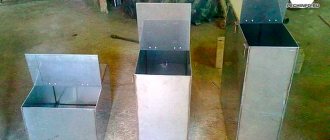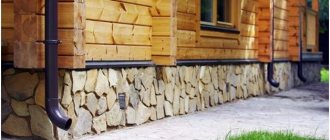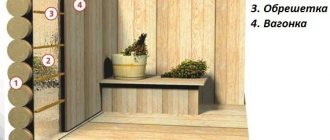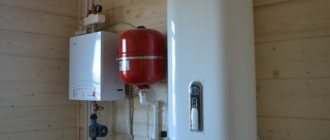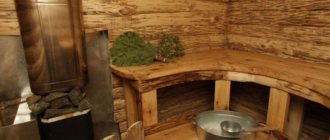A sauna tank on a pipe is a kind of stove-stove, familiar from old films. Hot water when taking a bath procedure is a natural attribute, which means that in the absence of a central water supply it is necessary to heat it. At the same time, the chimney in the bathhouse is designed to eject hot smoke from the firebox to the outside. Thus, significant thermal energy is lost uselessly. A water tank on a bath pipe allows you to combine these two processes, and the chimney begins to perform useful and necessary work.
A sauna tank on a pipe helps save space in the sauna
Materials for making tanks
The type of material used to make the sauna tank determines the durability and reliability of the structure, the speed of heating and cooling of the liquid. Water heating devices are made of stainless steel, cast iron and metal.
Stainless steel
The most popular material for the manufacture of tanks for heating water in a bathhouse is stainless steel. It is resistant to corrosion, fire, high humidity, deformation and damage.
In addition, stainless steel products have high thermal conductivity, hygiene and resistance to temperature changes.
The stainless steel tank can be presented in cylindrical and rectangular shape.
Proper care of stainless steel products guarantees efficient operation and a long service life.
Made of cast iron
Cast iron remains the traditional material for making water tanks. It has good performance characteristics - low thermal conductivity, resistance to corrosion, deformation, mold and overheating.
The disadvantages of cast iron products include their impressive weight and complexity of installation.
In cast iron tanks, water heats up slowly, but also cools down over a long period of time. Therefore, one volume is enough to satisfy hot water needs for the whole day.
Made of metal
The cheapest option is metal tanks, which are susceptible to corrosion, rotting and deformation. Such characteristics can negatively affect the quality of water and the durability of the product.
It is strictly forbidden to paint metal devices with moisture-resistant paint, which can release toxic substances when heated.
Less popular are enameled tanks, which are sensitive to mechanical damage. If there are chips in the enamel, such devices are not recommended. To protect the heaters from possible corrosion, their surface is treated with a special heat-resistant compound.
Stainless steel tanks of the remote type are considered the most practical and reliable. Such designs are distinguished by their attractive appearance and safe operation.
Metal
Since water is hot, metal remains the best material for tanks. In addition to metal, wood and plastic are also used. These materials can only be used if they do not come into contact with objects heated above 90 degrees. Basically, the heating of water in the bathhouse is provided by metal tanks.
Here are the main types of such tanks:
- Installed on the chimney;
- Suspended (wall-mounted boiler form factor);
- Built into a sauna stove;
- Built into gas and other boilers;
- Remote for installation on a flat surface, floor and tabletop, as well as suspended.
The choice of a specific option is carried out according to the internal conditions of each bath. The power of the heat source, its type (stove or gas boiler), as well as the required amount of hot water are taken into account.
Another feature is how exactly the hot water in the bath will be used. Will it be a simple hot water tap or showers that require pressure. We will consider each option in more detail.
For metal tanks, there are several options for their design:
- Galvanized steel, painted with heat-resistant paint (not common);
- Enameled steel (the main type of tanks for baths, boilers, kitchen heaters);
- Thick-walled galvanized steel without paint (developed following the example of galvanized buckets and utensils);
- Cast iron enameled (very reliable, but rare);
- Stainless (the best type of tanks).
The most affordable ones are enamel tanks. They are mass produced. They are specially made for heating hot water. For little money you can find options for any capacity and configuration.
Difference by type
The simplest designs of heat exchangers are coils with ends removed from the tank: one takes in liquid at room temperature, the other releases hot liquid.
More complex ones are a system consisting of two metal tanks with anti-corrosion properties - cylindrical and rectangular in shape with connecting pipes.
There are two ways:
- This photo shows an option for installing a heat exchanger in a steam room and a tank in a wash room.
The second option is to install a heat exchanger with a tank inside the steam room.
Advantages of installing a heat exchanger in a steam room
- high water heating speed;
- saving free space in the steam room;
- Wide range of options for installing the tank - in a steam room or in a shower room.
Types of heat exchangers for sauna stoves
Structurally, the heat exchanger can be a coil or a tank with a maximum volume of 5 liters and two pipes for connecting a water tank/radiator.
According to the mounting method, heat exchangers are divided into two types:
- internal. Such products are fixed on one of the side walls of the furnace or mounted on its bottom. It is also possible to install a water jacket, which literally encircles the fuel chamber from the inside or is located in the space between the stove casing and the walls of the firebox;
- external. Heat exchangers of this type are fixed to the chimney or attached to the wall of the furnace.
Prices for different types of heat exchangers
Internal type heat exchangers have the best heat saving indicators. The water in them will heat up until the stove cools down completely down to its last brick or stone.
The fastest heating of water is provided by internal heat exchangers and external ones installed on the chimney. At the same time, the first products often imply the need to make design changes/additions to the sauna stove, while the second cannot be called a decoration for the steam room (a wide tank does not fit well into the interior).
Example of an internal steel heat exchanger in a brick kiln
If we compare products in terms of ease of installation, the palm is occupied by heat exchangers that are hung on the outer walls of the furnace. Such products have a long service life and do not spoil the appearance of the stove, but the water in them takes longer to heat up and cools much faster.
What are bath water tanks made of?
First, let's talk about what the tank can be made of.
In addition, stainless steel containers are quite heat-resistant and durable and are not negatively affected by sudden temperature changes. However, there is one drawback: the prices for stainless steel bath tanks exceed the cost of their steel “brothers” made of enameled steel. To be fair, we note that this can be neglected: a stainless steel container will last longer than its steel counterparts.
In modern production conditions, enameled steel tanks also have a long service life. Parameters such as resistance to corrosion and high temperatures indicate a fairly high quality of products: the tanks in the bathhouse do not rust.
But still, enameled steel cannot be compared with stainless steel (although it is successfully used in the production of tanks). The only thing in which steel containers are superior to their stainless counterparts is price: the cost of enameled products is approximately 1.5-2 times lower.
Stainless steel and steel sauna tanks are by far the most popular, although there are other options (for example, cast iron sauna tanks).
Anti-corrosion treatment
For metal tanks, corrosion is the main problem. The key solution is stainless steel, but for now, the price for it remains 10 times higher than usual (in terms of weight). In reality, a stainless steel tank costs not 10 times more than a regular steel tank, but much less. This happens because the thickness of the walls of the stainless steel tank is made smaller. There is no reserve required for thinning due to corrosion.
Anti-corrosion treatment of tanks is carried out in the factory. Technologies in this area do not stand still and are constantly being improved. Zinc has the strongest adhesion to steel. Various protective layers are applied on top of it.
There are two popular options for anti-corrosion protection. This is either paint for a hot water tank in a bathhouse, or glassy enamel, which is applied at high temperature. Enameled tanks are better protected from corrosion and high temperatures than painted ones.
The general technology for their manufacture is the same as for conventional enamel cookware. Glass-based food grade enamel is used for tanks and utensils, without the addition of lead.
Information. In some cases, they carry out independent anti-corrosion treatment of tanks. All homemade structures need it (with the exception of stainless steel). You need to use only specially developed compounds and apply them to a clean and grease-free surface.
Purpose
To obtain hot water in the wash room of your bath complex, several types of structures have been developed that operate on different types of fuel. But the most inexpensive is installing a heating tank on the heater and obtaining hot water together with heating the steam room.
The advantages of such a device are due not only to the reduction in the cost of hot water when heated with gas or electricity. This design avoids the risk of fire and electric shock when using these types of fuel.
Autonomous water heating systems are especially in demand for summer cottages and households in places with no natural gas supply. In this case, such tanks can be used for heating water and for household needs. The main thing is to choose the right tank for the volume and type of installation and install it correctly.
Selecting the boiler power
It is important to take care of the installation of an RCD (residual current device). This will prevent accidental electric shock to bathhouse visitors.
This will prevent accidental electric shock to bathhouse visitors.
Based on the design features and range of water heaters, we can state the following:
- If you don’t have gas, then the heaters and boilers using this fuel will “pass” by your bathhouse. If you are the happy owner of a gas bath, then you can no longer consider other options.
- Electric water heaters are expensive, but there are no problems with installing the device. It is cut into the water supply and plugged into an outlet. And that’s it – you can use it. Moreover, an electric boiler is a “one-time” device - this device will prepare the next portion of hot water after 3-4 hours. In addition, instantaneous and electric storage water heaters are afraid of excessive humidity in the bathhouse “atmosphere”.
- If you are a supporter of budget solutions and want to have a supply of hot water until the heater goes out, then you will undoubtedly like wood-burning water heaters. In this case, the water in the tank is heated by the stove itself, which imposes some restrictions on the process of installing such water heaters. They are installed during the construction of the heater. But if you haven’t missed the moment, then you won’t find anything better.
Well, now let's talk about volume:
- Large companies need an appropriate amount of water. Therefore, for a company of 4-5 people, you need either an instantaneous water heater or a boiler with a capacity of 100-150 liters.
- One or two people or a company of three people will get by with a 50-80 liter boiler.
- The bathhouse for one “user” is equipped with a 30-liter boiler.
water heaters “Success”,
which are tanks with a capacity of 40 to 250 liters, heated by heating elements at 1.5-2 kW.
Water heater “Success” 125 l
The tank is made of sheet steel, at least a millimeter thick, and the heating element is equipped not only with a thermostat, but also with a mechanical temperature regulator.
Less sociable bathhouse owners will be interested in
model GARANTERM ER 150 V
Water heater GARANTERM ER 150 V
electric boiler for 150 liters, boiling water heating element for 1.5 kW. This dressing can serve a company of 3-4 people, who can not only rinse off in front of the steam room, but also take a full-fledged hot shower. Moreover, the heater body, as well as the outlet fittings, are made of stainless steel, and moisture-resistant polyurethane foam is used as a heat insulator.
The cost of the heater is 10-11 thousand rubles.
model Ermak KVS-10-2-90
Water heater model Ermak KVS-10-2-90
wood-burning storage water heater made of stainless steel with a capacity of 90 liters. This boiler boils water using both wood and heating elements with a power of up to 2.5 kW. Moreover, this boiler has relatively modest dimensions - the wood-burning firebox is built directly into the storage tank of the heater.
The cost of a stainless steel model is 15,000 rubles.
What designs can be used
You can place the tank in the bathhouse in different ways. The main types used are:
Built-in design. In this case, the chimney pipe runs inside the tank. This structure is considered stationary, non-removable and is installed during the manufacture of the chimney. The tank can be made in the form of a pipe (cylindrical version) or have a rectangular cross-section
It is important to securely seal the bottom entrance of the pipe to prevent water from leaking out of the tank. To use water, outlets are made from the tank directly into the shower stall or intermediate tank
Given the elevated location of such a tank, water flows by gravity.
The device of a heater with a tank on the chimney
- Hanging structure. Such a system is removable, i.e. installed on an existing chimney. The tank is placed close to the chimney pipe and securely attached to the column. Such containers can be purchased or made by yourself. This design is typical when a gutter is formed on the back wall, repeating the shape and diameter of the chimney, which makes it possible to bring the surfaces as close as possible and ensure high-quality heating.
Design of a hanging tank for a bath
- Remote design. In principle, the water container itself can be placed in any convenient place (for example, in a shower). In this case, the energy of the chimney heats the coolant, which is sent to heat the water container. When such a heat exchanger is mounted on a bath pipe, the installation height of the tank must be selected so as to ensure gravity flow of the coolant according to the laws of physics, i.e. the warm flow rushes upward, and the cooled flow – downward. This design provides for the presence of additional elements in the form of a heat exchanger, but it also allows you to place the tank itself in the right place.
Water circulation diagram with a remote design of the tank and stove in the bathhouse
Depending on the design, the tank can be placed at different height levels. 3 options can be implemented:
- At the stove level: the base of the tank is placed on the top of the stove, which means no additional brackets are required. The main disadvantage is that the height does not allow gravity flow of water for showering. In this case, it is scooped by hand.
Tanks at furnace level
- On the chimney column. This design is located at a certain height, which eliminates the previous drawback. Mounting the tank requires special brackets, and the weight of the structure is limited.
- Attic level. Here there is a reliable support for the tank in the form of a ceiling. The problem arises in a cold attic, where you will have to think about external thermal insulation.
Diagram of installing a water tank on a chimney at the attic level
When calculating the parameter, they usually proceed from the following requirement: 10 liters per person for a bath procedure and 5 liters per person when taking a shower. In addition, a reserve should be created for unforeseen circumstances.
There are various forms of water tanks for a bath on a chimney
The dimensions of the container also depend on the design and dimensions of the chimney. The most common type is a sauna tank with a 115 mm pipe. Naturally, a bath tank for a 150 mm pipe is made of a larger diameter, regardless of the need.
The choice of volume of a metal water tank depends on the number of family members. Formula for determining the volume of a cylindrical tank
Remote large capacity
The water tank for the bathhouse is remote; if a large container is used, it is installed on the floor. For baths with several sinks and showers, a pump must be installed.
It creates the required pressure, which makes it possible to use any modern plumbing fixtures, spray showers, hydromassage cabins and much more.
When installing the pump, care must be taken to ensure that it does not cause excessive noise.
It is reduced by the use of plastic pipeline fittings and the pipes themselves.
Also, the pump installation should be carried out outside the bathhouse.
Nowadays pipes are inexpensive, and you can make an elbow for the pump in any convenient place, for example, in a plumbing hatch, next to the water meter or in the utility room of the bathhouse.
The “water tank with heat exchanger” type arrangement for a bathhouse is suitable for heating the largest volumes of water. The tank capacity can exceed hundreds of liters. In other heating systems, such options are difficult to implement.
Information. All pipes, connecting fittings and pump must be heat-resistant (if plastic is used). For metal, ordinary ½ or ¼ inch steel pipes are optimal.
And a little about scale in boilers
If a summer house or cottage with a bathhouse is located in a region with hard tap water, scale will form in the boilers. It is deposited in the place of extreme temperature heating, reduces the rate of heating of water, and significantly reduces the conductivity of heat in the pipes. Scale from hard water constantly builds up in an uneven layer and has a high coefficient of heat resistance.
The appearance of scale inside the pipes reduces the strength of the samovar sections of the chimney, reduces the service life of the entire structure, and deteriorates the samovar-type heat exchanger. If pipes and boilers are not cleaned of scale in a timely manner, water floods the fuel compartment of the stove.
Recipes for folk remedies against scale
- Baking soda. In the tank, bring the water to a boil, pour a pack of soda into it. Then let the water cool and bring it to a boil again. Drain the water and soda, fill the tank with clean water, pour half a glass of vinegar essence into it. Bring to a boil, leave to cool. Bring to a boil again and pour out after half an hour. The influence of soda and acid loosens the scale; it is removed with a hard sponge or brush.
- Lemon acid. Not sparing the bags of lemon, pour it into a tank of cold water, then bring to a boil. Let it sit for a while, drain the water with citric acid, fill the tank with clean water, and bring to a boil. The acid breaks down all the scale deposits, the tank is rinsed with clean water. The method is cheap, fast-acting, but has a significant drawback: the acid, acting on scale, affects the metal material, its surface will be rough, and fresh scale will quickly appear again. It will become more and more difficult to clean the boilers with lemon each time.
- Vinegar. Pour a glass of vinegar into the filled tank and boil for 20 minutes. The acid acts effectively, its disadvantage is the residual odor. You need to clean the boiler with the windows open, then rinse the system thoroughly and ventilate the room for a long time.
Today, all methods of heating water in home baths are widely used. The designs of the various systems are well thought out, easy to use and safe.
It is important to fulfill all installation conditions efficiently.
Material for production
Steel types are also considered productive today. This kind of substance has many advantages; it is resistant to changes in temperature and pressure, retains and conducts heat well. It is resistant to rust, corrosion and deformation. Cast iron products for water have similar properties, although it is worth noting that they are much heavier in weight, despite the fact that they maintain temperature for a long time and take a long time to build up the required level of heat.
As experience shows, devices have long been widely used in practice, but they also have their own characteristic disadvantages. If you install the container incorrectly, the water will boil faster than the room begins to fill with steam. Subsequently, the steam room produces moist, heavy air, which does not act as effectively on the body as dry steam.
How to weld a water tank with your own hands
The simplicity of the design and mechanism of action allows you to make a sauna tank with your own hands. Thus, you can not only save money, but also quench the thirst of the inventor. First of all, you need to decide on the shape of the container and the material. You can choose a large diameter pipe or sheet material of a suitable size.
To make a sauna tank at home you will need the following set of tools:
- grinder with cutting and cleaning wheels;
- locksmith tools;
- welding machine;
- drill with metal drills;
- fitting;
- solvent and primer, brush;
- protective clothing and respiratory and eye protection.
Step-by-step production:
- First you need to prepare the material. The metal is cleaned of dust and all kinds of contaminants.
- Using a grinder, cut out blanks of the required size - in total there should be 6 planes-edges, which will form the tank - four vertical, a bottom and a lid.
- The side parts are installed on the bottom edge and secured by welding.
- All parts must be mutually perpendicular to ensure the stability of the structure.
- The edges are first ground to the correct shape.
- After making sure that the workpiece has right angles and bevels or there are no gaps, you can begin welding the seam around the perimeter of the bottom from the inside.
- When the first seam has cooled, the slag is beaten off and welded to the second one.
- The same applies to the seams between the vertical edges.
- Next, they are welded from the outside along the seam. In this way, the necessary tightness is achieved. The cover will be removable, so the welding work is completed.
- Using a drill, holes are made for pipes of the required diameter.
- Holes for mounting are also drilled.
- After securing all fittings and pipes, you can check the tank for leaks by filling it with water.
- If there are no leaks or fistulas, you can install the structure in place and begin operation. Otherwise, welding work will have to be repeated on each seam until the inaccuracies are eliminated.
The last stage will be finishing work. The surface of the tank must be degreased with a solvent, and the seams must be cleaned with a file. After the solvent has dried, a heat-resistant primer is applied.
Securing the remote tank and installing the heat exchanger
Remote sauna tank
For a sauna stove, a tank with a volume of 80-120 liters is sufficient. This container must be hung on the wall of the bathhouse so that the level of the tank is higher than the stove.
Scheme for connecting the tank and installing the furnace with heat exchanger
Connection diagram
Step 1. Choose a place to mount the tank. This can be either a steam room or a shower room behind an adjacent wall. We determine the mounting height using recommendations for the slope of inlet/outlet pipes.
Layout of the furnace and tank
Step 2. Most experienced craftsmen do not recommend hanging the remote tank directly on the wooden wall of the bathhouse. Therefore, we measure the width of the tank, saw the rail into several sections of the appropriate size, and fasten the sections to the wall of the bathhouse with nails.
Step 3. The tank must have technological holes for attaching it to the wall. We secure the tank with self-tapping screws or dowels, checking horizontal and vertical. The structure can be further strengthened with brackets, fixing them under the bottom of the tank.
Brackets under the tank bottom
Step 4. The remote water tank has three or four pipes. Two of them are intended for connection to the heat exchanger, the third is for filling the tank with water (it may not be there), through the fourth hot water is supplied to consumers. A check valve is connected to the pipe through which the tank will be filled with water. If the system is open (water is added manually through an open tank lid), then a non-return safety valve is not needed.
A faucet with or without a shower hose is connected to the pipe from which heated water will flow.
Step 5. There are two pipes left, to which you should connect corrugated steel pipes or install a copper network. Connections are made using fittings. It is permissible to use metal-plastic pipes, connecting them with adapters to the pipes of the tank and heat exchanger. All threaded connections are sealed with thread sealant.
Flexible water supply
Prices for metal-plastic pipes
metal-plastic pipes
Step 6. A tap is connected to the pipeline that leads from the tank to the heat exchanger to drain water from the system. The operation of draining the liquid will need to be performed every time after completing bath procedures, otherwise during cold weather the water may freeze in the pipes.
Furnace heat exchanger installation diagram
Step 7. A heat exchanger is hung on the wall of the furnace (or its fittings are brought out through the technological openings of the furnace, and the coil is located inside so that in the future there is no contact of the body metal with an open flame). The fasteners are tightened. Flexible corrugated hoses or pipes are supplied and connected to the heat exchanger with fittings. If necessary, holes are drilled in the wall with a diameter slightly larger than the diameter of the pipes.
Drilling holes
Pulling liners through holes in the wall
Connecting the line to the heat exchanger
Step 8. The system must be tested for leaks by supplying water under pressure.
Sauna stove with heat exchanger connected
An example of connecting a remote tank to the heat exchanger of a sauna stove
An example of connecting a remote tank to the heat exchanger of a sauna stove
Step 9. If you have a metal stove, then you can put it into operation. The brick kiln will have to be completed, finishing, testing and other preparatory work must be done. However, metal stoves can also be lined with bricks (they are placed on edge) on two or three sides. Such a screen additionally accumulates heat, increasing the efficiency of the furnace.
How to install?
The work is carried out in several stages:
- It is necessary to select a location for installation. It is not recommended to hang the hot water tank directly on a wooden wall surface. First you need to secure a layer of thermal insulation. You can glue a sheet of foam plastic and on top of it, marking the places where the screws are attached, drill holes with a smaller drill.
- We secure the container and begin marking and drilling holes for supplying pipes from the heat exchanger. You will need a large drill, but it is better to drill in several passes, starting with a small size, gradually bringing the hole to the required diameter.
- We connect pipes with taps. The hot water supply pipe should come from the top of the heat exchanger, and the chilled water pipe should be located below. You can use metal-plastic pipes, although experts recommend installing a copper pipe, but it is very expensive.
After all these operations, you can perform a test run of the water heating system, but it is better not to use the first boiling water for washing. And then gather all your family and friends and go to the steam room to enjoy hot steam in the steam room and hot water in your washroom or shower.
Advantages and disadvantages
When heating a bathhouse, you do not need to waste resources on heating water
A tank of sufficient capacity will provide residents with heated water for hygiene procedures and household needs. The liquid in the container eliminates the problem of dry air. Compared to water heating devices running on gas or electricity, the advantage of using a tank is that there is no additional consumption of resources. Connecting the reservoir to the stove will also help out in the event of a temporary shutdown of the supply of main resources.
The disadvantages of tanks depend on the material and type of construction. In steel containers, water cools quickly; cast iron containers are heavy. Installing a tank on a pipe requires special skills. The heating rate is affected by the thickness of the walls of the product.
Remote, built-in or on a pipe?
Tanks for baths can be built-in, remote, or on a pipe - and each has its own pros and cons. Compare and evaluate which one is right for your bath.
Advantages of a tank built into the oven
Once upon a time, water tanks for the bathhouse were only built into the stove - so that the lower part of the boiler was placed in the upper part of the firebox - the hottest one. And the bottom of the tank in this case is in direct contact with the stove fire. Water can be drawn from such a container directly, or it can be discharged through the built-in tap.
Remote tank for a bath: pros and cons
Thanks to the ability to install a heat exchanger in the oven, the tank itself does not need to be tied to a specific place - it can even be installed in a washing room. According to the known laws of physics, cold water will fall into the heat exchanger, and hot water will rise back.
Tank on a pipe - hot water without problems!
But it happens that the bathhouse is used not for two or three hours, but for the whole day - for example, when they wash in it, but the time after the fire has already passed. Then the ideal option is a tank on a pipe in which the water will be constantly heated to the desired temperature. This is on the pipe through which the smoke comes out of the stove - and its temperature can reach 500? C. Such tanks can be quite large - after all, the heating area of the pipe is quite large, and the water will heat up quickly and evenly.
There is one more advantage of this design - in such a bathhouse, smoke leakage through a crack in the pipe is impossible, because The tank in this case serves as a kind of fuse.
Process Features
The chimney pipe is a mandatory element of a sauna stove, through which the combustion products of fuel (smoke) are discharged and the necessary draft is provided to maintain combustion in the firebox. The smoke rising through this pipe heats it to a temperature of more than 450-500 degrees, which forces measures to be taken to isolate the chimney from the elements of the bath structure.
Since ancient times, the question has arisen about how to profitably use the removed heat. When carrying out bath procedures, you need hot water for washing after visiting the steam room. For these purposes, there is always a container (tank), which provides the required volume of water.
Nuance! Using the heat of a chimney is considered an effective and economical way to heat it. Fundamentally, the issue is resolved by placing the tank at the top of the chimney pipe or by heating the coolant using the heat of smoke.
A water tank installed on a pipe effectively saves heat from smoke removal, thereby heating the water.
What is the advantage of a tank on a pipe? The following positive aspects can be highlighted:
- heating occurs quickly and does not require additional fuel;
- the high temperature in the tank is automatically maintained during the entire heating time of the furnace;
- The tank-pipe for sauna stoves can have a significant volume, because it is possible to use the chimney along its entire length.
Tanks-pipes for the chimney can be of various lengths and designs
What materials are used
The sauna tank is made of metal, but the specific material is selected taking into account financial capabilities, volume and heating characteristics. The most popular designs are:
- Cast iron. Main advantages: high strength, durability, while the water temperature remains for a long time after the furnace has stopped firing. At the same time, the cast iron container warms up slowly, and most importantly, it has a large mass, which requires reliable support when installing the structure.
- Steel. The cheapest and most accessible material used in economical structures. The water in a steel tank heats up quickly, but also cools quickly after the fire stops. The most important disadvantage is corrosion destruction, which requires protective covers. One of the common options for eliminating this drawback is the use of enamel tanks. However, when choosing this material, it should be taken into account that with local damage to the enamel, accelerated corrosion begins at the source of damage.
- Stainless steel. A tank on a pipe for a stainless steel bath is considered the most common design, because... optimally combines cost and durability. The material is more expensive than ordinary steel, but is not subject to corrosion and has a long service life. At the same time, stainless steel can be welded, and you can make a tank from it yourself.
The remote design of the tank is in more gentle conditions. Extreme temperatures (400-500 degrees) only affect the heat exchanger located on the chimney. The walls of the tank itself do not heat above 70-80 degrees, which means it can be made from different materials. In addition, it is usually placed on the wall, where the risk of damage is reduced. In such conditions, decorated enamel containers become very popular. Supply pipes for a remote tank in a bathhouse can be made of metal, composite material and heat-resistant plastic
It is important to ensure their thermal insulation
Remote heat exchanger for a bath
The simplest and most affordable way to make a tank for a bath is the built-in version, when it is hung on the chimney. It’s not for nothing that such a system is called a samovar in everyday life, because it uses the same principle, i.e. heating the water with hot smoke rising through the inner pipe. Such a tank is installed during the construction of the stove or installed by dismantling a section of the chimney.
In the selected location, a pipe is mounted on brackets, so that the gap between the outer diameter of the chimney pipe and the inner body of the tank pipe provides the required volume. The base is welded at the bottom of the tank body, and all gaps are sealed with heat-resistant sealant. To drain water, an outlet with a tap is welded (Fig. 1). The upper part of the tank is closed with a lid.
Figure.1 Installation diagram of a bath tank
In principle, the tank body can be made in a rectangular shape for the required capacity. The wall thickness is selected taking into account the volume. To make a small tank with a volume of about 50-55 liters, you can use a metal sheet with a thickness of 0.9-1.2 mm, and for a container of more than 70-80 liters you will have to use metal with a thickness of at least 1.5 mm.
If there is a water supply to the bathhouse, then a remote system is more suitable. It is shown in Fig. 1. In this case, a coil is mounted on the chimney. The hot water exits towards the remote tank from above, and the coolant returns, respectively, from below. During installation, it is necessary to install the necessary shut-off equipment (valves, taps, taps).
When installing a tank in a bathhouse on a chimney pipe, you will need the following tools and equipment: a welding machine and electrodes with a diameter of 2.5-3 mm, a grinder, a hacksaw, an electric drill, a hammer drill, a hammer, pliers, a set of keys, a caliper, a tape measure.
The sauna tank on the chimney pipe allows you to have a supply of hot water without unnecessary fuel consumption.
Such a system uses the energy of futile smoke, which gives a significant economic effect. A system of different designs can be made and installed with your own hands.
Mounted
This design option is hung on a standard metal sauna stove. The presence of metal walls of the furnace is mandatory, since heat is transferred through one of them to the water in the tank. This design is not widely used due to low efficiency, but its main advantage is maximum simplicity.
A hanging tank for a bathhouse is usually made of thin stainless steel. It is placed outside the stove and located in a visible place in the bathhouse. Stainless steel is not only an ideal material for water tanks, but also has a beautiful appearance.
When you need the simplest tank for hot water in a bathhouse, wall-mounted installation is best. With it, you don’t even need to do pipe routing. The tank is delivered completely ready.
The bath tap for hot water is also included with the tank upon purchase. The spigot is located at the center of the lowest point, and the bottom is usually flat or has a conical stamping.
The inconvenience of this location of the tap is the small distance from the floor. In addition, the stove is often placed in the corner of the bathhouse. One side of it is occupied by the door, and the other by the tank. Thus, it turns out that the tap is in a very inconvenient place. This problem is solved by installing a pump.
Information. For a wall-mounted tank, the sauna stove should be standard. This is either a ready-made structure, or a home-made one, but having at least one flat metal wall of the appropriate size for the tank.
Wall-mounted tanks have either a removable lid or a filler neck with a diameter of at least 10 cm. A filler neck is much more common. It makes cleaning and processing the internal space somewhat more difficult, but makes the structure more durable.
The cheapest designs of hanging tanks are welded from sheet steel and galvanized. The service life of such structures is short. Stainless steel thin-walled structures are gaining popularity.
Due to their small wall thickness, they are affordable. Steel enameled tanks are rarely used as hinged tanks on the stove.
Types of tanks
All tanks are divided into types according to two criteria: installation method and material of manufacture. According to the installation method, tanks are:
- built-in;
- remote;
- samovar type (mounted on a chimney).
According to the material of manufacture:
- cast iron;
- stainless steel;
- made of enameled steel.
Each type has models that differ in shape, volume, and wall thickness. Most containers are equipped with standard taps and have shower outlets, but there are also those from which water is drawn through the top using a ladle. In order not to make a mistake when choosing, you should familiarize yourself in detail with the advantages and disadvantages of all these types.
Built-in tanks
Built-in tanks
The most economical and convenient option. The tank is installed during the laying of the furnace. Its lower part is located inside the firebox, due to which the water is heated directly by the flame. Hot water is drawn through the top using a ladle or using a built-in tap.
Brick oven with water tank
Due to direct contact with fire, the walls and bottom of the container must be as thick as possible, therefore the most preferred material for such a tank is cast iron with a thickness of 5 mm. Stainless steel tanks with wall thicknesses of 1 and 1.5 mm are considered no less popular. Enameled steel containers are not suitable for this installation method. Cast iron tanks are bowl shaped, stainless steel tanks are usually cube or cylinder shaped.
Cast iron water tanks
Advantages of built-in tanks:
- water heats up quickly;
- the water temperature is maintained for a long time;
- free space is saved since the tank does not protrude beyond the stove;
- easy installation.
Flaws:
- the heat transfer of the furnace decreases, since the main part of the heat is spent on heating water;
- the dimensions of the tank are limited by the size of the furnace;
- the tank must have thick walls, which increases its weight and cost.
Metal tanks for sauna stoves
This method is convenient in cases where no more than 4 people are steaming in the bathhouse at the same time, or people wash separately. For example, if 3-4 people take turns steaming in a bathhouse, this takes quite a lot of time, and accordingly, it will take longer to maintain the water temperature by adding firewood. The built-in tank allows you to save on fuel while remaining hot for a very long time. But for large companies, this option is not the most optimal, since it does not provide the required amount of water.
Remote tanks
Remote tanks
The remote tank is located at a distance from the firebox and is connected by pipes to a heat exchanger built into the furnace. Without this, its operation is impossible. Most often, such a tank is installed in a washing room or mounted on the wall of a steam room next to the stove, if its dimensions are larger than the area of the firebox. When choosing a location for a container, it is necessary to take into account that the length of the pipes should not exceed 2.5-3 m. Remote tanks can be made of stainless steel or enameled, cylindrical, rectangular or even triangular in shape - for installation in the corner of the room.
Triangular shaped water tank
Advantages:
- the tank is installed where it is more convenient;
- Large containers can be used;
- there is no direct contact with fire, so the tank can be enameled and with thinner walls.
If 6-8 people regularly steam in a sauna, a remote tank is an excellent option.
Flaws:
- without maintaining a fire in the firebox, the water quickly cools;
- the oven cannot be used without water in the circuit;
- more complex installation compared to a built-in tank.
Remote tank connection diagram
Tank on a pipe or “Samovar” design
This option involves installing a tank around a chimney, and in some models the pipe is located outside the tank, in others - inside.
Hot water tank on a pipe
Design option for a water tank on a pipe
In height, the tank can occupy the space from the stove to the ceiling, partially extend into the attic, or be attached only to a small section of the chimney above the stove. The most convenient container shape is cylindrical, but there are many models with rectangular, triangular and oval sections. Heating of water is carried out using smoke passing through a pipe, which has a very high temperature.
Oval shaped water tank
Advantages:
- fast and uniform heating of water;
- does not reduce the heat output of the furnace;
- space saving;
- you can install a container of any volume;
- the water stays hot for a long time.
This tank is suitable for any bathhouse and any number of people. It all depends on the size of the container.
Stoves with water tanks on a pipe
Flaws:
- installation complexity;
- increased soot deposition on the walls of the chimney.
When installing the tank, it is necessary to select the correct fastening elements in order to securely fix the tank in a vertical position. In addition, you will need to install pipes for supplying cold water and discharging hot water, and install a faucet.
Samovar type tank
Tank on the chimney
Boiler for a bath
Boilers are effective in regions where there is no firewood. Gas and solid fuel options are popular. It is better to prefer solid fuels on peat. Unlike coal, they do not pollute the surrounding area.
There are two options with boilers. Either connect the tank to the heat exchanger in the bathhouse (the heat exchanger is placed in the combustion chamber of the boiler), or install the tank on the boiler itself.
Information. Unlike stoves, boilers are not assembled from bricks, but are purchased ready-made. The design with a heat exchanger has maximum efficiency; by the way, it can be implemented without a ready-made expensive boiler. This is discussed below.
You can use homemade boilers for a bath from a pipe, but this requires good quality welding work, which is the main difficulty. A common option is to manufacture the boiler and tank from large-diameter stainless pipes.
Wood-burning sauna boilers with a tank are produced ready-made. Structurally, they are designed in the same way as a regular sauna stove and differ in size. Their water capacity is usually larger, and the area for installing stones for soaring is smaller.
How and how to connect the external tank to the heat exchanger
Remember that the elements in contact with the stove become hot, their surface temperature exceeds 100 0C. Therefore, the pipes must be made of stainless steel (cast iron will not work, as it is susceptible to corrosion). But ordinary pipes are allowed to be made of metal-plastic; they can even be replaced with flexible hoses. The main thing is that the diameter is 1 inch or 3/4, otherwise the circulation will be poor.
Use tangit for seals, and paronite for fittings. Feel free to replace factory elements with non-standard ones, but made of heat-resistant material. Don't forget about the drain valve - it is simply necessary to preserve the system for the cold season or to quickly remove stagnant liquid. Otherwise, during frosts, the remaining water will freeze and burst the pipes.
How to make a stove for a bath of a suitable size with a coupling of 400, 500, 530 mm
The choice of a homemade device depends on the dimensions of the paired compartment and the priorities of the owner. The manufacture of any type of structure is regulated by the standards PPB 01–93 and SNiP 41–01-2003. Regardless of whether the oven is horizontal or vertical, a number of general rules apply:
- For a heater you will need a sheet of 30x35 cm. The distance from the top of the heater to the bottom of the tank is at least ten centimeters.
- The back wall is completely welded, and a door is mounted on the facade.
- A coupling made of steel strip with a thickness of 400, 500 or 530 mm is attached to the top. Its width is approximately 5 cm. Half is welded to the body, and the protruding part is used for assembly.
- When installing the chimney, leave a third of the top area of the tank unsealed so that you can fill in water. A door with a handle is attached to the bay opening.
- A tap with a valve is welded at the bottom of the tank.
Important! The heater is filled with cobblestones only to half the space. You can equip the entrance hole with an iron rod to prevent cobblestones from falling out
Vertical homemade device
In a design built on a vertical principle, the grate is located above the heater.
The diameter of the stove will depend on the caliber of the selected pipe.
When installing a vertical sauna stove with your own hands, adhere to the following algorithm:
- Cut off a piece of pipe approximately 0.8 m long.
- Clean the cut edges.
- The bottom is welded from below - a circle of the same diameter as the pipe itself.
- Cut out the vent opening at the bottom.
- The grate bars are installed. They are located slightly above the blower hole.
- A slit for the combustion compartment is cut above the grate.
A hole is made on top of the stove for the chimney. All openings are equipped with doors adjusted to size. After the work is done, the stove is sanded and coated with paint.
Do-it-yourself horizontal design: photo
A distinctive feature of this type of device is that the firebox is moved from the steam room to the dressing room, which makes ignition easier and faster. But horizontal ovens require much more space.
Photo 2. A horizontal stove with a brick lining, located in the dressing room, requiring a fairly large space for installation.
To manufacture the device, a piece of pipe measuring 0.8 m is taken and the openings are sanded. A grate is installed below. A metal sheet sufficient to cut out a rectangle of the required size is suitable for it. The middle is cut out of the material, while the edges are left not too narrow. Then the metal rods are welded. The finished grate is mounted to the body.
Photo 3. Homemade horizontal sauna stove with a water tank and a compartment for stones.
For the rear section of the device, a metal rectangle slightly larger than the diameter of the pipe is suitable. If you plan to install a heater, you need to take this into account when cutting and add a larger allowance.
The sheet for the facade will be approximately the same size. Holes for the firebox and air vent are cut out in it. The mold is then welded to the front of the pipe. A square hole of approximately 12x12 cm is cut out from the top of the body. This will be the chimney. Next, the doors are hung.
Photo 4. Small metal sauna stove with a firebox and blower, with a hole for the chimney.
Before painting, the unit is thoroughly cleaned of plaque and rust. As a finish, you can line the structure with brick.
Attention! If you are painting the stove, at the end of the procedure, heat it outside!
HOW TO MAKE A WATER TANK WITH YOUR OWN HANDS
Making a tank backpack is not much of a problem. A drawing of one of the options for a future water heater is shown below.
For manufacturing you will need two pieces of steel pipes. A pipe with a diameter of 125 mm is used for the inner wall. For the outer part, you can use a workpiece with a diameter of 175-250 mm.
In addition, you will need to cut out two bottoms and two walls from thin sheet metal. A neck is welded in the upper part, and a fitting is cut into the bottom for connecting the tap. All work is performed only using a carbon dioxide semi-automatic machine. The backpack tank is attached to the chimney using metal loops.
Making a stove from an iron barrel
To create this unpretentious product, first cut out the bottom and get rid of the top, leaving a cylinder. Then you need to install a grate on the bricks. The inside of the barrel is lined with bricks, which are placed edgewise. The remaining 2/3 of the area is laid with stones. At the final stage, a chimney is made.
For safety, the structure is closed with a lid. Although this is correct, it is not very convenient, because the lid will have to be removed from time to time when more steam is needed.
